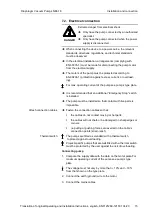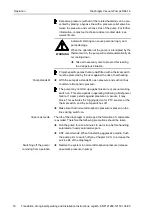
Servicing
Diaphragm Vacuum Pumps N86.16
22
Translation of original Operating and Installation Instructions, english, KNF121260-121531 04/20
a) Preparatory step
1. Disconnect the pump from the power supply; check that the
pump is electrically dead and secure this.
b) Removing pump head
1. Mark the position of carrier (
1
), intermediate plate (
3
), and
head plate (
4
) relative to each other by a drawing line (
M
) with
a felt-tip marker. This is to ensure that the parts will be reas-
sembled in correct position at a later stage.
2. Release the nuts (
6
) and remove them together with the disk
springs (
5
).
The disk springs are fitted in order to maintain the tension of
the wave diaphragm right across the temperature range of the
pump.
3. Remove head plate (
4
).
4. Remove O-ring (
10
) from head plate (
4
).
5. Remove the valve plate (
11
) and the intermediate plate (
3
).
c) Changing diaphragm
1. Release the retainer plate (
7
) by turning it anti-clockwise with a
pin wrench or a wrench for retainer plate. While doing so, hold
the connecting rod extension (9) in place with holding tool.
Take care to ensure that the washer (
12
) does not slip under
the diaphragm support (
8
).
2. Remove wave diaphragm (
2
).
3. Check that all parts are free from dirt and clean them if neces-
sary (see Chapter 9.2.2).
4. Slide a new wave diaphragm (
2
) onto the threaded bolt of the
retainer plate (
7
).
The wave diaphragm assembly consists of two equivalent
parts placed on top of one another; the top and bottom are
identical.
5. Apply a small amount of heat-resistant thread adhesive to the
thread of the retainer plate (
7
).
6. Screw the retainer plate (
7
) with wave diaphragm (
2
) into the
connecting rod extension (
9
); to tighten the retainer plate, use
the wrench for retainer plate/the pin wrench to turn it clockwise
(tightening-torque: 4.6 Nm). While doing so, hold the connect-
ing rod extension (
9
) in place with the holding tool; and hold
the wave diaphragms so that they do not twist.
d) Changing valve plate and sealing
1. Check that intermediate plate and head plate are clean. If
damages, distortion, or corrosion are evident on these parts
they should be replaced.







































